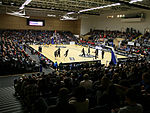Newcastle upon Tyne (UK: NEW-kah-səl, locally (listen) new-KASS-əl), often simply Newcastle, is a city and metropolitan borough in the county of Tyne and Wear, North East England. It is on the River Tyne's northern bank opposite the towns of Gateshead and Jarrow and the towns of North Shields and Tynemouth are directly east of the city. It is approximately 59 miles (95 km) east of Carlisle, 14 miles (23 km) north-northeast of Sunderland, 19 miles (31 km) northeast of Durham, 120 miles (190 km) southeast of Edinburgh and 291 miles (468 km) from London. Historically, the city was part of Northumberland before becoming a county of its own prior to 1974. It is now the largest city in both Tyne and Wear and North East England.
Culturally, the city is famed for its nightlife; bakery chain Greggs; television personalities Ant & Dec; the Great North Run half-marathon; and Newcastle United Football Club. Famous landmarks include the Newcastle Cathedral, the Tyne Bridge; the Swing Bridge; The Castle; the St Thomas’ Church; the St Mary's Cathedral, Grainger Town including Grey's Monument and the Theatre Royal; the Millennium Bridge; St James' Park; and Chinatown. Historically, the city's economy was dependent on its port as one of the world's largest ship building and repair centres. Today, the city's economy is diverse with major economic output in science, finance, retail, education, tourism, and nightlife.
It developed around a Roman settlement called Pons Aelius and the settlement later took the name of a castle built in 1080 by William the Conqueror's eldest son, Robert Curthose. In 1400 Newcastle separated from Northumberland to become a county of itself. The city became the metropolitan county town of Tyne and Wear from 1974 until 1986. It is locally governed by Newcastle City Council, part of the North of Tyne Combined Authority.
It is part of the Core Cities Group, as well as the Eurocities network. The city is part of the eighth most populous urban area in the United Kingdom, Tyneside, it also includes the large towns of Gateshead and South Shields.











